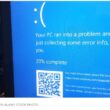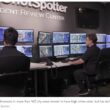The universal headache
The amount of noise generated within a receiver system is one of the factors that sets the limits on such systems. Of particular importance is the noise present at the receiver front end. The higher the input noise level at the receiver, the greater the amount of signal required to achieve a desirable signal-to-noise ratio. This in turn sets the sensitivity of the receiver. In this article we will examine how noise affects the receiver system and how to determine noise levels.
A simple resistor will produce a noise voltage across its terminals. The amount of noise power produced by a resistor is dependent on the bandwidth in which the noise is measured and the temperature, but it is independent of the resistance value. The noise power produced by a resistor in a given bandwidth at a given temperature can be determined by the formula shown in Equation 1. The noise voltage is dependent on the resistance value, along with bandwidth and temperature.
Figure 1 depicts a resistor in series with a noise generator. The resistor is assumed to be noiseless, and the noise power developed in the resistor is found by using Equation 1. The noise power developed in a bandwidth of 1 Hz at a temperature of 298° K is equal to 4.1124 × 10-21 watts. Comparing this to 0 dBm (1 mW) yields a figure of -174 dBm. This is the maximum available power that is deliverable to a matched load. Because a matched load would divide the source noise voltage by one-half, the formula for finding the root-mean-square (RMS) noise voltage across the resistor must be multiplied by a factor of 2, as shown in Equation 2. Assuming a noiseless resistor, the voltage of the noise generator in Figure 1 is equal to 9.069 × 10-10 volts.
In Figure 2, a signal generator represented by ES is connected in series with a noise generator represented by EN and a 50-ohm resistor, RS. The bandwidth is 10 kHz. The voltage level of the signal generator is 0.5 µV, and the voltage level of the noise generator is 0.09 µV. At the output terminals the voltage signal-to-noise ratio is 5.56:1, or 14.9 dB. This is the open-circuit, or no-load, signal-to-noise ratio.
Figure 3 shows the same circuit with a load resistor, RL (equal to RS), connected across the output terminals. The noise generated by RL is represented by the noise generator, EN2, at a level of 0.09 µV. The bandwidth is still 10 kHz.
In Figure 4, the circuit depicted in Figure 3 is redrawn. The two noise generators, EN1 and EN2, are replaced by a single noise generator, ENT. Notice that the output voltage level of the noise generator, ENT, is equal to 0.127 µV — not 0.18 µV, as would be obtained by simply adding the two voltages. Because the noise voltages are at random phase relationships (noncoherent), the resultant of the two 0.09 µV generators is found by the root-sum-square (RSS) method, as shown in Equation 3.
Referring again to Figure 4, the signal voltage across the load resistor, RL, is one-half the signal generator voltage, or 0.25 µV. The noise voltage across the load resistor, RL, is equal to one-half the voltage of the noise generator, or 0.0636 µV. Therefore, the voltage signal-to-noise ratio across the load resistor, RL, is 0.25/0.0636 = 11.9 dB. Connecting the matching load resistor across the generator circuit has reduced the signal-to-noise ratio from the open-circuit value of 14.9 dB to 11.9 dB under matched load conditions. Thus it can be stated that the noise figure of the matched load is 3 dB. That is, connecting two equal impedances in parallel as shown in Figure 4 results in the reduction of noise by 3 dB compared to the open-circuit condition, and the reduction in the signal by 6 dB compared to the open-circuit condition. Thus the signal-to-noise ratio is degraded by 3 dB, compared to the open-circuit condition.
Figure 5 shows the same circuit as in Figure 3, except that the load resistor, RL, is 500 ohms. The noise voltage will be higher with the higher impedance. Using Equations 1 and 2 for a 10 kHz bandwidth at 500 ohms, the noise generated in RL is 0.286 µV. Figure 6 shows the two noise generators, EN1 and EN2, replaced by a single generator, ENT, at a level equal to the RSS of the two noise generators. The noise voltage of ENT is 0.3 µV.
The signal voltage appearing across RL is: 0.5 x 500/(500+50) = 0.5 x 0.91 = 0.455 µV
The noise appearing across RL is: 0.3 x 500/(500+50) = 0.3 x 0.91 = 0.273 µV
The signal-to-noise ratio is then equal to: 20 log 0.455/0.273 = 4.44 dB
However, because the load impedance, RL, is not equal to the source impedance, RS, a correction factor must be applied to this signal-to-noise ratio. The correction factor is:
10 log RL/RS = 10 log 500/50 = 10 log 10 = 10 dB
Adding this 10 dB to 4.44 dB yields a signal-to-noise ratio of 14.44 dB. Comparing this figure to the open-circuit signal-to-noise ratio of 14.9 dB shows that the noise figure of this circuit is 14.9 – 14.44 = 0.46 dB.
In a narrow-band FM receiver with a bandwidth of 16 kHz (system deviation at ±5 kHz), the receiver input noise level reference for a 0 dB noise figure is shown in Equation 4. Thus the theoretical minimum noise floor in a bandwidth of 16 kHz is -132 dBm. Typically, in a conventional narrow-band FM system, a signal-to-noise ratio of 4 dB will produce 12 dB SINAD at the receiver audio output. If the receiver sensitivity is -115 dBm (0.4 µV), the noise floor of the receiver must be at -119 dBm. This means that the noise figure of the receiver is -123 – (-132) = 9 dB.
Let’s examine how noise level at the antenna affects the significance of line loss between the antenna and the receiver input.
We will use the example above where the receiver noise floor was -119 dBm, or 0.25 µV. Suppose that the signal level at the antenna is 10 µV and the noise level is 2 µV, yielding a signal-to-noise ratio of 13.98 dB at the antenna terminals. Suppose, too, that the line loss is 6 dB. This brings the signal level at the receiver input to 5 µV and the noise level (from the antenna) at the receiver input to 1 µV. The noise level at the receiver input (from the antenna) combines with the receiver input noise of 0.25 µV for a combined noise level of
EN = √(12 + 0.0252) = 1.0308 µV
The signal-to-noise ratio at the receiver input is then equal to
20 log 5/1.0308 = 20 log 4.85 = 13.72 dB
The line loss of 6 dB has degraded the signal-to-noise ratio from 13.98 dB to 13.72 dB — a change of slightly more than 0.25 dB — because the noise from the antenna is still the dominant noise, as it is several decibels greater than the receiver’s equivalent input noise level. The transmission line loss has little effect on the signal-to-noise ratio at the input to the receiver, as long as the noise from the antenna (and present at the receiver input) is several decibels greater than the equivalent input noise level at the receiver input.
Conversely, if the signal at the antenna is 5 µV and the noise level at the antenna is 0.5 µV, the signal-to-noise level at the antenna is 20 dB. Using the same receiver and the same line loss of 6 dB, the signal at the receiver input is 2.5 µV, and the noise at the receiver input (from the antenna) is 0.25 µV. The total noise at the receiver is
EN = √(.252 + .252) = 0.3535 µV
The signal-to-noise ratio at the receiver input is then
20 log 2.5/0.3535 = 17 dB
In this case, the transmission line loss caused a 3 dB degradation to the signal-to-noise ratio at the receiver input from what it was at the antenna terminals.
Often, we tend to get overly concerned about line loss or other losses ahead of the receiver input. But, as shown here, sometimes those fears or concerns are misplaced.
For example, suppose we are concerned about placing a filter ahead of the receiver input because the insertion loss (at the desired frequency) seems too great. If the noise level across the antenna terminals is fairly high, the insertion loss of the filter probably will have little adverse effect on the overall receiver system performance. The positive effects of the filter will probably greatly outweigh the slight negative effect of the filter’s insertion loss. As long as the noise from the antenna is still several decibels greater than the receiver’s equivalent input noise, the attenuation between the antenna and the receiver input is causing little harm to the system.
Until next time — stay tuned!
Harold Kinley is the author of three books, including Standard Radio Communications Manual and The Radioman’s Manual of RF Devices. A certified electronics technician, he holds an FCC First Class Radio-telephone License and an amateur radio operator “Extra” class license.

















